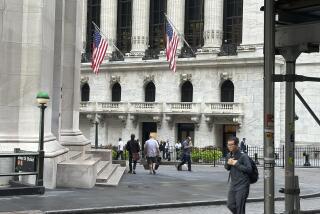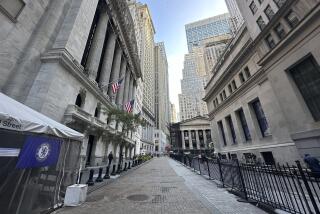Correction Ahoy: Wall St. Wakes to Fed Rate Reality
America has never enjoyed greater prosperity, President Clinton confidently declared in his State of the Union speech.
The irony would be poignant indeed if U.S. stocks last week lurched into the first official bear market since 1990.
It is, however, probably too early to crawl into a bunker, despite the steep market decline last week that left the Dow Jones industrials down 2.6% Friday, 4.6% for the week and 6.6% year-to-date.
From their respective record highs this month, the Dow has now slumped 8.4% and the Nasdaq composite index has slid 8.2%. If you were hoping late last year for a market “correction” to make share prices more reasonable, your wish is in the process of being fulfilled.
On Friday, interest rate worries finally appeared to rattle even some of those stock investors who ignored the Federal Reserve’s three rate increases in 1999. The government’s report that the economy grew at a torrid 5.8% annualized rate in the fourth quarter--and that a key barometer of wages and benefits rose at a faster-than-expected 1.1% pace--raised the odds that the Fed will make a bold rate move when it meets Tuesday and Wednesday.
Wall Street had been prepared for a quarter-point rate hike, to 5.75% for the Fed’s key short-term rate, the federal funds rate. Now, a half-point hike, to 6%, is a serious possibility.
But far more worrisome is what Fed chief Alan Greenspan and his fellow central bankers might believe they will have to do to rates as the year wears on. Even as Clinton hails our unprecedented prosperity, the Fed is clearly in the mode of trying to bring that prosperity to heel by slowing the economy.
The question is simple enough: How high must interest rates go to finally brake U.S. consumer and business spending? The answer is: Good question!
Despite last year’s Fed-driven jump in general market interest rates, including the prime lending rate (from 7.75% to 8.5%) and conventional mortgage rates (from 6.75% to more than 8%), many consumers and businesses barely seemed to notice.
Consumer spending surged 5.3% last year, while business investment in new plant and equipment jumped 8.3%.
“You’d think there is some limit to how much people can spend,” said David Wyss, economist at Standard & Poor’s Corp.
There might well be a limit--except that, for many consumers and businesses, the stock market’s continuing gains in ’99 more than offset the impact of higher rates.
Think of it this way: The increase in the prime lending rate last year raised the annual simple interest cost on a $100,000 loan at prime from $7,750 to $8,500.
But $100,000 invested in the average U.S. stock mutual fund produced a return of $27,500 last year.
With numbers like those, who’s afraid of the big, bad Fed?
*
And with numbers like those, no wonder many investors were actually borrowing to buy stocks in November and December, pushing the total of so-called stock margin debt to record highs. Greenspan, at the Senate confirmation hearing last week for his fourth term, conceded that margin borrowing has become a particular concern for the Fed, although he declined to say what the central bank might do about it.
Still, by Friday, the stock market’s swoon suggested that more investors were growing nervous about the extent to which the Fed might go to take the economy’s growth rate, and share prices, down a few pegs.
Robert Bissell, chief investment officer at Wells Capital Management in Los Angeles, believes the stage is set for an extremely volatile market in the near term, perhaps worse than the swings investors have endured (or precipitated) in recent weeks.
“People made a hell of a lot of money [in stocks] in the fourth quarter,” Bissell noted. It shouldn’t be terribly surprising if some investors choose to take some money off the table now, he said.
The highflying tech stocks in the Nasdaq market would be natural targets for heavier profit-taking, of course.
Wireless technology darling Qualcomm, which people couldn’t pay enough to own late last year, has plunged in recent weeks on concerns over its stratospheric valuation. It didn’t help when the company last week warned that its shipments of chipsets for wireless phones might decline in the second quarter--though Qualcomm insisted that, in a world in love with wireless technology, any decline would be temporary.
From its intraday peak price of $200 early this month, Qualcomm has slumped 45%, to $110.56 as of Friday.
But Bissell believes that investors should view declines in leading tech stocks, in particular, as a gift. With demand for U.S. technology worldwide unlikely to abate much in coming years, he says, “It’s hard for us to build a bearish case” about the tech sector longer term.
Investors who own shares outside the tech sector, however, might in fact have good reason to root for a sharper pullback in major tech shares.
Ned Riley, chief investment strategist at State Street Global Advisors in Boston, notes that many stocks in the “old economy”--from drug issues to bank stocks to airlines--have been under pressure for much of the last year.
“Many of them have already experienced a fairly serious correction” in their prices, Riley points out. And those stocks have looked worse when held up against the continuing boom in tech stocks.
If tech stocks were to fall more sharply in coming weeks, Riley argues that “it would make many of the old-economy stocks more attractive” by default.
Wishful thinking? Maybe. The super-bearish case on Wall Street right now is that the market is far more vulnerable than it yet understands, given still-high stock valuations overall, rising interest rates, and the potential for inflationary pressures to continue to build.
Greenspan would almost certainly love to see the stock market finally pay attention to him--and shudder. A meaningful drop in share prices could give many consumer-investors the reason they haven’t had for the last year or more to stop filling their shopping carts to overflow at Target, Wal-Mart and Home Depot.
But then what? If an economic slowdown finally ensues, and the Fed signals that interest rates have gone up enough, history suggests investors are likely to warm to stocks again--and quickly. The only question is the distance between here and there.
*
Tom Petruno can be reached by e-mail at [email protected]
(BEGIN TEXT OF INFOBOX / INFOGRAPHIC)
‘Correction’ in Full Swing
The January market sell-off has pulled many big-name stocks down sharply from their recent highs. A sampling:
*--*
Ticker Recent Fri. Drop from Stock symbol peak close recent peak General Electric GE $159.50 $134.00 --16.0% Motorola MOT 154.13 128.25 --16.8 Microsoft MSFT 119.94 98.25 --18.1 Home Depot HD 69.75 55.63 --20.2 Alcoa AA 87.25 69.50 --20.3 Johnson & Johnson JNJ 106.75 84.25 --20.8 Wal-Mart WMT 70.25 55.13 --21.5 Amgen AMGN 76.50 59.69 --22.0 Oracle ORCL 62.56 47.38 --24.3 Adobe Systems ADBE 79.00 57.56 --27.1 S&P; 500 1,478.38 1,360.16 --8.0
*--*
Note: Recent peaks may be intraday highs.
Source: Times research
More to Read
Inside the business of entertainment
The Wide Shot brings you news, analysis and insights on everything from streaming wars to production — and what it all means for the future.
You may occasionally receive promotional content from the Los Angeles Times.










